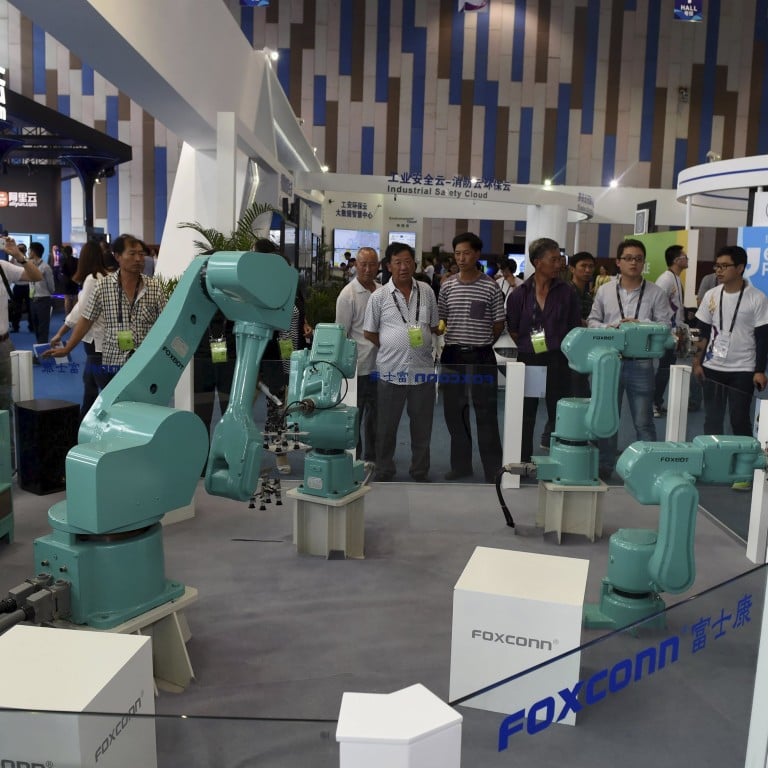
Foxconn’s Foxbot army close to hitting the Chinese market, on track to meet 30 per cent automation target
Foxconn, the world’s biggest contract electronics maker, has been developing industrial robots as it targets 30 per cent automation at its Chinese factories by 2020, it said this week.
The Taiwanese company, which lists Apple among its clients, is also now on the verge of marketing its Foxbots to other manufacturers on the Chinese mainland, it told the South China Morning Post.
According to senior management, re-purposed robotic solutions and automated assembly will be Foxconn’s next focus as it bids to slim its massive workforce and build new sales channels.
Previous media reports that claimed it was eyeing 70 per cent automation within three years are erroneous, the company said, pointing to comments issued by Foxconn CEO Terry Gou at last week’s annual general meeting.
The company, which has been keeping quiet about its robotics projects, opened its robot testing lab in Shenzhen, Guangdong province, to reporters from the Post last weekend.
Its Chinese factories, including those in Shenzhen, are already filled with over 50,000 fully operational industrial robots, as well as hundreds of thousands of other pieces of automated equipment, said Day Chia-Peng, general manager of Foxconn’s automation technology development committee.
He said the company plans to add at least another 10,000 robots a year to its facilities in China.
READ MORE: China’s Alibaba, Foxconn invest US$236 million in SoftBank’s robotics business
But this may fail to satisfy chairman and founder Gou, who said in 2011 that he expected to have one million robots operating at its Chinese plants by last year.
Instead, the company still employs over one million workers in China.
“It was kind of a dream, in terms of numbers. We hoped it would work out, but the reality proved different,” Day said.
Foxconn began developing its own industrial robots in 2007. It now has 1,600 employees at two factories in Shenzhen and Jincheng, in Shanxi province, who churn out 10,000 Foxbots a year, Day said.
The machines are capable of performing more than 20 manufacturing tasks, including pressing, printing, polishing, packaging and testing.
Using them to replace staff in so-called “3D” jobs – positions that are deemed dirty, dangerous and dull – is the company’s top priority, Day said.
The company was motivated to focus on this area due to safety concerns and manpower shortages in recent years, he said.
READ MORE: US$154 billion rise of the robots planned for Pearl River Delta manufacturing
Foxbots should hit the market soon, and the first customer is likely to be another Chinese manufacturer, he added, without giving a name or deadline.
Early this year, Gou said Foxconn would continue to deepen its investment in robotics. Day’s team will focus on researching ways to further automate assembly lines that require the most number of bodies, he said.
As such, it is keeping an eye out for any breakthroughs in automated assembly in the electronics manufacturing industry.

“We couldn't help but make a lot of blunders,” he said, using the difficulty of replicating people’s hand-eye coordination as an example. “It’s hard work.”
He said the company was focusing more on flexible reprogramming so the robots could be reused, or reformatted, further down the road. This is especially important as product cycles in the electronics industry keep shortening.
“Whatever robotic solution is delivered for our industry, it will have to be able to be re-purposed every few months,” he said.
The actual robot is just one part of the solution package. Grippers, sensors, vision systems, parts feeders and software are “at least as important – if not more so,” Day added.
However, he urged local authorities in China to proceed with caution rather than overheat investment in the sector, or look to robots as a cure-all solution for the nation’s labour shortages. He also stressed that they were not a tool to counter the economic slowdown China now faces after decades of unchecked growth.
READ MORE: Building work starts on first all-robot manufacturing plant in China’s Dongguan
Authorities in Guangdong said early this year they would spend 943 billion yuan (US$152.07 billion) on replacing human labour with robots by 2018.
Cities in the province are handing out annual subsidies of between 200 million and 500 million yuan to makers of robots and manufacturers who install robots on assembly lines.
Robots are also set to take over factories in China’s Pearl River Delta area, in the south of the country, as manufacturers there step up their tech investments to take advantage of new government incentives.
China is already bristling with low-end industrial robotics that can perform routine tasks like pressing and polishing, due to all the industrial parks set up in nearby cities, Day said.
Some 200,000 intelligent robots were operating in the country at the end of 2014, the IFR said.

